Trials and Tribulations of the Tribes and the Stones
|
|
|
|
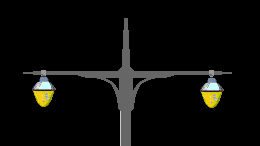 Originally adorned with acorn shaped pendant style lamps, these light poles were installed on the major approaches built at
the time to connect to the Triboro Bridge. They graced what would become
the northern end of the Brooklyn Queens Expressway and western
extension of the Grand Central Parkway in Queens. They were placed on
newly widened Bruckner Boulevard and the forerunner section of the
future Major Deegan Expressway in the South and West Bronx. They also graced the FDR
East River Drive approach to the Triboro from Midtown Manhattan,
the Henry Hudson Bridge and the Marine Park Bridge, between Brooklyn
and the Rockaways.
Originally adorned with acorn shaped pendant style lamps, these light poles were installed on the major approaches built at
the time to connect to the Triboro Bridge. They graced what would become
the northern end of the Brooklyn Queens Expressway and western
extension of the Grand Central Parkway in Queens. They were placed on
newly widened Bruckner Boulevard and the forerunner section of the
future Major Deegan Expressway in the South and West Bronx. They also graced the FDR
East River Drive approach to the Triboro from Midtown Manhattan,
the Henry Hudson Bridge and the Marine Park Bridge, between Brooklyn
and the Rockaways. |
|
|
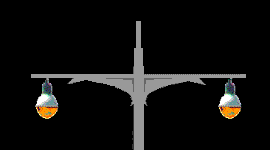 The Bronx-Whitestone Bridge that opened three years after the
Triboro sported a leaner, plainer successor lamppost, compared to the more ornate Triboros that served as a transitory style stemming from the older cast irons. The pretense of resembling the Empire State was relegated
to the light pole's tip, above the mast. The pole itself was just a
plain, cylindrical standard pole until that point.
The Bronx-Whitestone Bridge that opened three years after the
Triboro sported a leaner, plainer successor lamppost, compared to the more ornate Triboros that served as a transitory style stemming from the older cast irons. The pretense of resembling the Empire State was relegated
to the light pole's tip, above the mast. The pole itself was just a
plain, cylindrical standard pole until that point. The Whitestones took over as the pole de riguer on the new expressways as New York city's erstwhile freeways were designated, from the opening of the Whitestone Bridge on, through the early-mid 1950's building of the Van Wyck and Brooklyn Queens Expressways. Whitestones preceding those highways were adorned with Gumball shaped teardrop-pendant style lamps as opposed to the latter ones given Westinghouse "cuplight" pendants. |
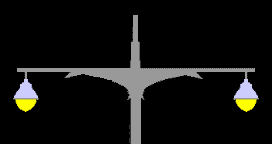 They lit up the southern extension of Manhattan's FDR East River
Drive, the new vehicular lanes placed on the venerable Brooklyn
and Queensboro Bridges, the controversial Gowanus Parkway in
Brooklyn, which was later upgraded to commercial standards and incorporated into the overall Brooklyn Queens
Expressway family of freeways, which also had the 'Stones on its 1950s elevated and cantilevered Brooklyn stretches south of the Kosciuszko Bridge.
They lit up the southern extension of Manhattan's FDR East River
Drive, the new vehicular lanes placed on the venerable Brooklyn
and Queensboro Bridges, the controversial Gowanus Parkway in
Brooklyn, which was later upgraded to commercial standards and incorporated into the overall Brooklyn Queens
Expressway family of freeways, which also had the 'Stones on its 1950s elevated and cantilevered Brooklyn stretches south of the Kosciuszko Bridge. Not normally associated with the parkways, they were also on the Bronx end of the Henry Hudson Parkway. Since the old Gowanus Parkway was clearly demarcated by its builder for later incorporation into a high volume, commercial grade expressway, the decision to use Stones instead of the usual Woodie wood standard parkway light poles can be understood. Less understandable is their presence on the more traditionally rustic Henry Hudson. It's possible that Robert Moses, who coordinated all these projects, planned on converting the bucolic Henry Hudson Parkway and its critically important eponymous bridge into a truck laden expressway, directly feeding into his planned Interstate 478 arterial complex via the old, ultimately doomed Miller West Side Highway. The Stones could also be found on LaGuardia Airport ramps and the Pulaski Bridge, a short span connecting McGuinness Boulevard in Greenpoint, Brooklyn, to Long Island City, Queens across the noxious Newtown Creek. |
|
|
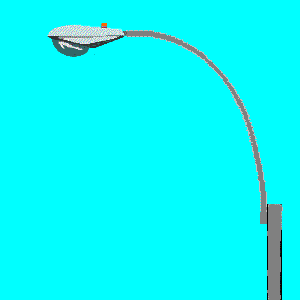 Both
the Tribes and 'Stones made it into the mercury vapor cobra head luminaire era, but
not without losses. Both lost their distinctive mast arms in favor of the wildly uplifting "Quarterloops" uplift arms made famous on Kojak,
in particular on the BQE Brooklyn Queens Expressway in the 1960's, followed by the Van Wyck Expressway and Queensboro Bridge
approach ramps in the early 1970's. The southern tip of the BQE,
winding toward the Belt Parkway kept its Whitestone mast arms and incandescent lamps into the 1980's. Both light pole standards put up a fight
that their castiron colleagues on the side streets could never
do. Both
the Tribes and 'Stones made it into the mercury vapor cobra head luminaire era, but
not without losses. Both lost their distinctive mast arms in favor of the wildly uplifting "Quarterloops" uplift arms made famous on Kojak,
in particular on the BQE Brooklyn Queens Expressway in the 1960's, followed by the Van Wyck Expressway and Queensboro Bridge
approach ramps in the early 1970's. The southern tip of the BQE,
winding toward the Belt Parkway kept its Whitestone mast arms and incandescent lamps into the 1980's. Both light pole standards put up a fight
that their castiron colleagues on the side streets could never
do.The Tribes adapted Westinghouse Silverliner vapor fixtures on the Triboro and Marine Park Bridges and the Grand Central Parkway approach to the Triboro. |
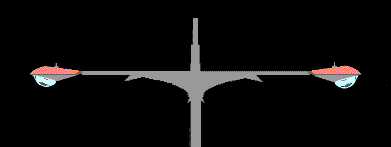 The Bronx-Whitestone Bridge 'Stones kept their finned masts while adapting
to the "Disgusted" looking mercury vapor GE M400 cobra heads, or perhaps more in keeping with their diamond shape and personality, viper heads. The 'Stones on the now Ed Koch, then Queensboro Bridge's upper
deck, Brooklyn Bridge and FDR East River Drive kept their finned masts with Westinghouse Silverliner OV-25 cobra heads, whose slim contours more closely resembled the cobra's elapidae family. The Bronx-Whitestone Bridge 'Stones kept their finned masts while adapting
to the "Disgusted" looking mercury vapor GE M400 cobra heads, or perhaps more in keeping with their diamond shape and personality, viper heads. The 'Stones on the now Ed Koch, then Queensboro Bridge's upper
deck, Brooklyn Bridge and FDR East River Drive kept their finned masts with Westinghouse Silverliner OV-25 cobra heads, whose slim contours more closely resembled the cobra's elapidae family. |
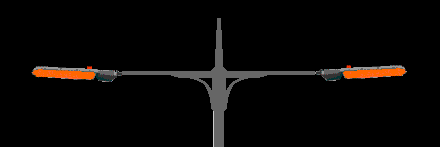 Sometime
around the 1980's, the Triboro and Whitestone Bridges both adopted
long tubed sodium fixtures, like the Thomas Betts LPS. Sometime
around the 1980's, the Triboro and Whitestone Bridges both adopted
long tubed sodium fixtures, like the Thomas Betts LPS. I always assumed that the tubes were installed to help in foggy weather. The long term survival of the Tribes and Stones on their respective namesake bridges seemed virtually assured. Wondering what luminaires they'd next wear appeared to be their only problem. If the nearby Throgs Neck Bridge offered any glimpse into the future back in the late 1990s, little cutoff fixtures like the TB113 may have been the fated successor to the LPS tubes. The careful eye back then noticed a handful of green Stones, still adorned with cuplights, on a ramp into LaGuardia Airport spanning the Grand Central Parkway. Thanks to the stingy Port Authority, mini Whitestones with working cuplights still adorned the Henry Hudson Parkway 235th Street walkbridge. Tribes still graced the Henry Hudson's namesake bridge as of 1996 when I originally wrote this. |

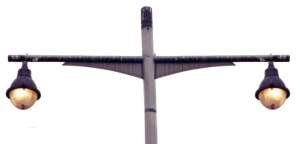
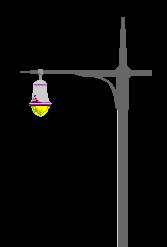 The tale about the trials, tribulations, rivalry and adaptability of two of the most iconic street lighting standards to ever grace New York City's arterial bridge and highway system, lamp posts I lovingly nicknamed after the mighty Great Depression era river crossings that heralded in their genesis.
The tale about the trials, tribulations, rivalry and adaptability of two of the most iconic street lighting standards to ever grace New York City's arterial bridge and highway system, lamp posts I lovingly nicknamed after the mighty Great Depression era river crossings that heralded in their genesis.
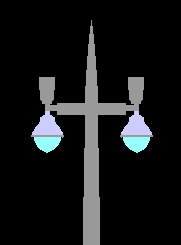 Image of a typical Miller West Side Highway twinlamp standard, with 1960's era
mercury vapor "cuplight" teardrop-pendant style lamps. As discussed elsewhere on this website, the bridges and early highways
built in New York City all had their own distinctive lampposts. The 1920-1930's
era parkways had their own bucolic looking Woodies, a rustic wood beam lighting standard style that still survive in isolated spots. The new bridges however, led
by the great godfather of their generation, the mighty Triboro Bridge,
were not meant to look bucolic, but rather empirical.
Image of a typical Miller West Side Highway twinlamp standard, with 1960's era
mercury vapor "cuplight" teardrop-pendant style lamps. As discussed elsewhere on this website, the bridges and early highways
built in New York City all had their own distinctive lampposts. The 1920-1930's
era parkways had their own bucolic looking Woodies, a rustic wood beam lighting standard style that still survive in isolated spots. The new bridges however, led
by the great godfather of their generation, the mighty Triboro Bridge,
were not meant to look bucolic, but rather empirical.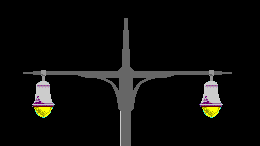 Image of a typical post-widening Bruckner Boulevard twinlamp, shown with Mission
Bell shaped lamps, most of which survived into the mid 1960's until the grand South Bronx secondary route was finally turned into a limited access arterial highway. The grand plan was for Bruckner Boulevard to become an expressway,
possibly explaining why that despite it being a secondary road, it
got the Triboros instead of the typical castirons relegated to
such roads. Its status as a main bridge approach probably has
much to do with it. The same went for the southern terminus of
the Grand Concourse, which fed into the nascent Major Deegan Expressway.
No other secondary roads would get them until the ongoing retro lamp post craze saw fresh aluminum casting of them planted in neighborhood settings they'd never originally been put in.
Image of a typical post-widening Bruckner Boulevard twinlamp, shown with Mission
Bell shaped lamps, most of which survived into the mid 1960's until the grand South Bronx secondary route was finally turned into a limited access arterial highway. The grand plan was for Bruckner Boulevard to become an expressway,
possibly explaining why that despite it being a secondary road, it
got the Triboros instead of the typical castirons relegated to
such roads. Its status as a main bridge approach probably has
much to do with it. The same went for the southern terminus of
the Grand Concourse, which fed into the nascent Major Deegan Expressway.
No other secondary roads would get them until the ongoing retro lamp post craze saw fresh aluminum casting of them planted in neighborhood settings they'd never originally been put in.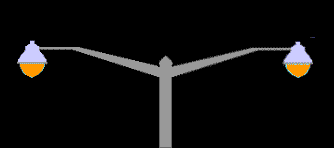 They appeared on Long Island, on Nassau County's Atlantic Beach
Bridge and the Robert Moses Causeway, far out in Suffolk County.
They appeared on Long Island, on Nassau County's Atlantic Beach
Bridge and the Robert Moses Causeway, far out in Suffolk County.